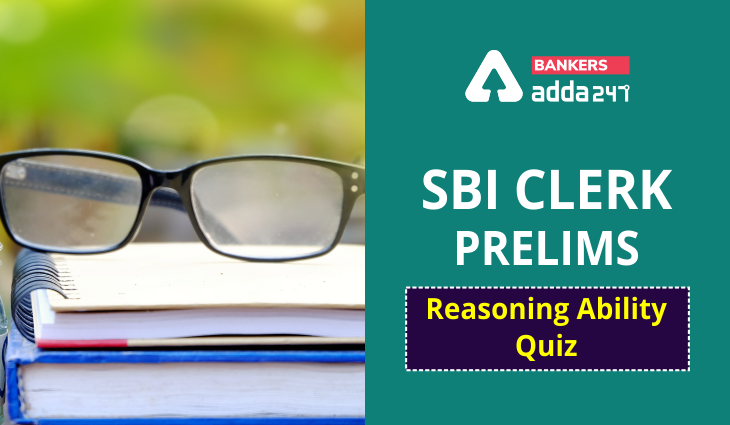Table of Contents
Direction (1-5): In these questions, relationship between different elements is show in the statements. The statements are followed by conclusions. Study the conclusions based on the given statements and select the appropriate answer:
(a) If only conclusion I follows.
(b) If only conclusion II follows.
(c) If either conclusion I or II follows
(d) If neither conclusion I nor II follows.
(e) If both conclusions I and II follow.
Q1. Statements: W≤R<T≥ S>X> B>F<K=M
Conclusion I: F≤T II: T>F
Q2. Statements: R≥P≥D=W≤Z= A>V=N
Conclusion I: R≥Z II: A>D
Q3. Statements: K=Q>E> G>J>Y≥D≤R<T
Conclusion I: K>T II: T≤K
Q4. Statements: I>P≤ Y≥T=M≥ W≥X<C=D
Conclusion I: Y>X II: X=Y
Q5. Statements: P<Q≤X=B≤ E=T>Y=U<L
Conclusion I: U<X II: X≤U
Direction (6-10): In these questions, relationship between different elements is show in the statements. The statements are followed by conclusions. Study the conclusions based on the given statements and select the appropriate answer:
(a) If only conclusion I follows.
(b) If only conclusion II follows.
(c) If either conclusion I or II follows
(d) If neither conclusion I nor II follows.
(e) If both conclusions I and II follow.
Q6. Statements: A>E<P≤V<D=W>T≥O>Q
Conclusion I: Q≤D II: W>E
Q7. Statements: Q<J≤O< D≤R>W=U>P
Conclusion I: R>Q II: D>U
Q8. Statements: Y=O≥E=W≥P<S≤G
Conclusion I: S>O II: P≤Y
Q9. Statements: H<T= R≤ X<V>Z≥S
Conclusion I: Z>T II: T≥Z
Q10. Statements: M≤ L=V=G>F=W<T≤R
Conclusion I: L>W II: G≥R
Directions (11-15): In this question, relationship between different elements is shown in the statements. The statements are followed by conclusions. Study the conclusions based on the given statement and select the appropriate answer.
(a) If only conclusion I follows.
(b) If only conclusion II follows.
(c) If either conclusion I or II follows
(d) If neither conclusion I nor II follows.
(e) If both conclusions I and II follow.
Q11. Statements: P>Q>R=U, U≥T<S, T≥W
Conclusions: I. R>W II. U=W
Q12. Statements: P>Q>R<U, U≥V>S, V<W
Conclusions: I. P>S II. P<S
Q13. Statements: A=K>X<L>N≤R, Q≥A, N=M
Conclusions: I. Q>X II. K>M
Q14. Statements: J=K>X<L>N≤R; Q≥K; J<M
Conclusions: I. Q>X II. X<M
Q15. Statements: J>K>X<L>N≤R; Q≥J<M
Conclusions: I. R<M II. M≥R
Practice More Questions of Reasoning for Competitive Exams:
Reasoning for Competitive Exams |
Reasoning Ability Quiz For SBI Clerk Prelims 2021- 17th May |
Reasoning Ability Quiz For SBI Clerk Prelims 2021- 18th May |
SBI Clerk Study Plan 2021 |
Solutions
S1. Ans(b)
Sol. I: F≤T (False) II: T>F (True)
S2. Ans(d)
Sol. I: R≥Z (False) II: A>D(False)
S3. Ans(d)
Sol. I: K>T (False) II: T≤K (False)
S4. Ans(c)
Sol. I: Y>X (False) II: X=Y (False)
S5. Ans(c)
Sol. I: U<X (False) II: X≤U (False)
S6. Ans(b)
Sol. I: Q≤D(False) II: W>E(True)
S7. Ans(a)
Sol. I: R>Q (True) II: D>U (False)
S8. Ans(b)
Sol. I: S>O(False) II: P≤Y(True)
S9. Ans(c)
Sol. I: Z>T (False) II: T≥Z (False)
S10. Ans(a)
Sol. I: L>W(True) II: G≥R(False)
S11. Ans.(c)
Sol. I. R > W (False) II. U = W (False)
S12. Ans.(d)
Sol. I. P > S (False) II. P < S (False)
S13. Ans.(a)
Sol. I. Q > X (True) II. K > M (False)
S14. Ans(e)
Sol. I. Q > X (True) II. X < M (True)
S15. Ans(d)
Sol. I. R < M (False) II. M ≥ R (False)
Click Here to Register for Bank Exams 2021 Preparation Material





 GA Capsule for SBI Clerk Mains 2025, Dow...
GA Capsule for SBI Clerk Mains 2025, Dow...
 The Hindu Review October 2022: Download ...
The Hindu Review October 2022: Download ...
 PNB SO Syllabus 2025 and Exam Pattern
PNB SO Syllabus 2025 and Exam Pattern




